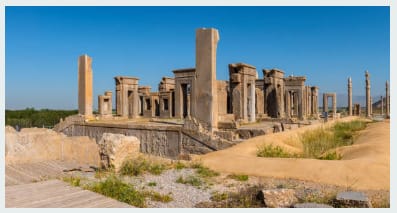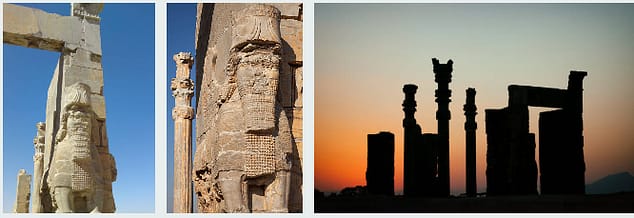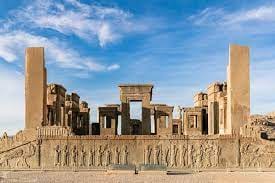Takht-e Jamshid Aka Persepolis
Takht-e Jamshid Aka Persepolis was the traditional center of the Persian Empire during the rule of the Achaemenid. Persepolis is located at a distance of around 70 km to the northeast direction of the contemporary city of Shiraz which is positioned in the Fars region of up-to-date Iran. In modern Persian, the place is known as Takht-e Jamshid which means Throne of Jamshid, and is commonly known as the Parseh. The most primitive remnants of Persepolis rendezvous from roughly 515 BC. To the very old Persians, the town was identified as Pārsa. The meaning of Parsa is “The City of Persians”. Persepolis is the Greek explanation of the actual name.

The citadel of Persepolis was declared a World Heritage site by UNESCO in the year 1979.
Construction
Archaeological proofs demonstrate that the most primitive remnants of Persepolis belong to 515 BC.AFrench archaeologist, André Godard who dug up Persepolis in the near the beginning of the 1930s, supposed that Cyrus the Great desired the place of Persepolis, but that Darius the Great constructed the veranda and various other grand palaces.
Darius had planned out the structure of the Apadana Palace and also the Council Hall. The council is a Tripylon or a hall that has 3 gates. He has also initiated the construction of the most important imperial Treasury and its background. These structures were finished throughout the sovereignty of his only son King Xerxes the Great. Additional edifices of the structure which were created on the veranda sustained in anticipation of the collapse of the Achaemenid Empire.
Archeological research
The very first Westerner who had visited the remains of Persepolis was Antonio de Gouveia. He was from Portugal. He had written about the cuneiform message after he visited Persepolis in the year 1602. His very first report on Persia was named “Jornada” was became available in the year 1606
The very first scientific experiments that were carried out at Persepolis were been supervised by Ernst Herzfeld who was also accompanied by Erich F Schmidt on behalf of the Oriental Institute which was a major section of the University of Chicago. Excavations were carried out 8 different times of year starting in the year 1930 and incorporated various other sites which were located quite close by.
Takht-e Jamshid

Herzfeld whispered the various causes which were at the rear of the building of Persepolis. A few of the reasons were the necessity for a grandiose ambiance, an imperial representation of their territory, and also to have a good time during the various extraordinary events that were celebrated in the region. One of the most important events was the “Nowruz”. For chronological motives, Persepolis was constructed on the location where the Achaemenid reign was being established, even though it was not the heart of the kingdom at that era.
Persepolitan structural design is well-known for the usage of numerous columns which were made of wood. Architects have decided that the use of stone was to be made, only when the huge cadres of the teak trees or Lebanon trees, which were brought from India, were not of the necessary sizes. The bases of the columns and also the capitals were constructed with the help of stone, still on wooden beams, but the survival of the capitals, which were made of wood is credible.
The construction at Persepolis comprises 3 general groups notably the military quarters, the treasury, and the reception halls as well as the occasional houses which are mostly reserved for the King. Well-known buildings of Persepolis consist of, the Gate of Nations which is commonly known as Xerxes the Great, the Great Stairway and also the Apadana Palace of Darius, the Tripylon Hall, the Hall of a Hundred Columns, and the Tachara Palace of Darius, as well as the palace of Artaxerxes III, the Hadish Palace of Xerxes, the majestic Treasury, the imperial Stables and also the very famous Chariot residence.
Site
Persepolis is located near a very small waterway named Pulwar. The Pulwar River flows up to the Kur River which is also known as Kyrus. The location comprises a terrace whose total surface area is somewhere around 125,000 square meters. The terrace to a definite extent is constructed artificially and is also cut partly out of a peak.

The eastern side of the constructions leans on Kuh-e Rahmet mountain which is known as the “the Mountain of Mercy”. The remaining 3 sides are shaped by keeping hold of walls, which fluctuate in their stature with the incline of the land. You will see a double stair that ranges between 5 m to 13 m in inclination. It is located on the western side of the structure.

With a view of having a terrace of the same level, the melancholy was packed with soil as well as heavy rocks, which were connected collectively with the help of clips, which were made out of metal. It is believed that the edifice of the extensive flight of steps was started in the year 518 BC.
The flight of stairs was designed to be the most important way into the veranda which was been constructed 20 m on top of the ground. The twofold flight of stairs acknowledged as the Persepolitan staircase, was constructed in proportion to the Great Wall which was on the west side. The total number of steps was around 111 steps, whereas the width of all the stairs was 6.9 m. The treads of the stairs were 31 cm long and also had a rise of 10 cm. In the beginning, the steps were supposed to be built to permit the ascend of the nobles and the royalty on horseback. Many novel theories put forward that the superficial risers permitted the visiting personages to uphold the royal manifestation while they were ascending. The pinnacle of the flight of stairs shows the way to an undersized courtyard placed on the veranda’s northeast side, which was direct to the opposite side of the Gate of Nations.
The most important material that was used in the construction of the Persepolis was the Gray limestone. After the innate rock had been staged and the low-lied had been filled in with stones and mud, and later the terrace was built. Most important channels that were required for sewage were dug secretively in the course of the rocks. A water tank was been elevated which was been utilized for the storage of water. The water tank was been constructed at the foot of the mount on the east side. Professor Olmstead recommended that the cistern be built at a similar time when the construction of the towers commenced.

The foundation of the terrace which was constructed didn’t have the same level. Indirectly it played the role of a fortress whose walls had targeted the invaders they were very helpful for the defenders to aim any segment of the exterior face. Diodorus writes about Persepolis which has 3 walls with fortifications, which had huge towers that used to act as the defense room for the security people. The height of the first wall was 7 m; whereas that of the second wall was 14 m and, the height of the third wall was 27 m. The third wall covered all 4 sides. Today you can see no remains of the walls.
How to reach
If you are planning to visit Persepolis you can take a direct flight and land in Shiraz. Shiraz is well-connected with various domestic and international airbases in the country. Many countries from Middle, and Southeast Asia as well as Europe have direct flights to Shiraz. For traveling further from the airport you can either rent a cab or hire a car and reach Persepolis.
Tours
Guided tours are easily accessed for Persepolis who would be happy to give you an idea about the various places in the region of Persepolis. Guides speaking local as well as English languages are available.
When to visit
If you are willing to visit Persepolis you should plan your trip around the period from October up to January.
Accommodation
The city provides you with high-quality lodging in and around Persepolis. The city also has numerous 3-star, 4-star, and also 5-star hotels. A variety of motels, food stalls, and hotels are stretched all along the city, thus you can have a bite of your favorite food items.

Why viewers still use to read news papers when in this technological globe the
whole thing is available on net?
Helpful info. Fortunate me I found your website unintentionally,
and I’m surprised why this accident didn’t came about earlier!
I bookmarked it.
This is my first time visit at here and i am actually pleassant
to read everthing at alone place.
Very nice article. I definitely appreciate this
website. Stick with it!
Way cool! Some very valid points! I appreciate you writing this write-up and the rest of the website is really
good.
Скорозагружаемые здания: финансовая польза в каждой составляющей!
В сегодняшнем обществе, где часы – финансовые ресурсы, экспресс-конструкции стали решением, спасающим для фирм. Эти современные объекты объединяют в себе высокую прочность, финансовую выгоду и молниеносную установку, что сделало их идеальным выбором для коммерческих мероприятий.
Быстровозводимые здания
1. Ускоренная установка: Моменты – наиважнейший аспект в финансовой сфере, и сооружения моментального монтажа обеспечивают существенное уменьшение сроков стройки. Это высоко оценивается в моменты, когда актуально быстро начать вести дело и начать зарабатывать.
2. Финансовая выгода: За счет совершенствования производственных операций по изготовлению элементов и монтажу на площадке, затраты на экспресс-конструкции часто снижается, по сравнению с традиционными строительными проектами. Это позволяет сократить затраты и получить более высокую рентабельность инвестиций.
Подробнее на http://scholding.ru
В заключение, быстровозводимые здания – это первоклассное решение для бизнес-проектов. Они включают в себя быстроту возведения, эффективное использование ресурсов и долговечность, что позволяет им лучшим выбором для предпринимательских начинаний, готовых к мгновенному началу бизнеса и гарантировать прибыль. Не упустите момент экономии времени и средств, лучшие скоростроительные строения для вашего предстоящего предприятия!
This design is spectacular! You most certainly know how to keep a reader entertained.
Between your wit and your videos, I was almost moved to start
my own blog (well, almost…HaHa!) Excellent job.
I really enjoyed what you had to say, and more than that, how you presented it.
Too cool!
I’m gone to convey my little brother, that he should also pay a quick visit this webpage on regular basis to get updated
from latest news.